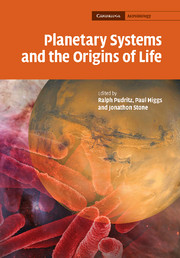Book contents
- Frontmatter
- Contents
- List of contributors
- Preface
- Part I Planetary systems and the origins of life
- 1 Observations of extrasolar planetary systems
- 2 The atmospheres of extrasolar planets
- 3 Terrestrial planet formation
- 4 From protoplanetary disks to prebiotic amino acids and the origin of the genetic code
- 5 Emergent phenomena in biology: the origin of cellular life
- Part II Life on Earth
- Part III Life in the Solar System?
- Index
1 - Observations of extrasolar planetary systems
Published online by Cambridge University Press: 13 August 2009
- Frontmatter
- Contents
- List of contributors
- Preface
- Part I Planetary systems and the origins of life
- 1 Observations of extrasolar planetary systems
- 2 The atmospheres of extrasolar planets
- 3 Terrestrial planet formation
- 4 From protoplanetary disks to prebiotic amino acids and the origin of the genetic code
- 5 Emergent phenomena in biology: the origin of cellular life
- Part II Life on Earth
- Part III Life in the Solar System?
- Index
Summary
Introduction
A decade has passed since the first discovery of an extrasolar planet by Mayor and Queloz (1995) and its confirmation by Marcy et al. (1997). Since this groundbreaking discovery, about 190 planets have been found around nearby stars, as of May 2006 (Schneider, 2006). Here we shall review the main methods astronomers use to detect extrasolar planets, and the data we can derive from those observations.
Aitken (1938) examined the observational problem of detecting extrasolar planets. He showed that their detection, either directly or indirectly, lay beyond the technical horizon of his era. The basic difficulty in directly detecting planets is the brightness ratio between a typical planet, which shines mainly by reflecting the light of its host star, and the star itself. In the case of Jupiter and the Sun, this ratio is 2.5 × 10–9. If we keep using Jupiter as a typical example, we expect a planet to orbit at a distance of the order of 5 astronomical units (AU, where 1 AU = 1.5 × 1011 m = distance from Earth to Sun) from its host star. At a relatively small distance of 5 parsecs from the Solar System, this translates into a mean angular separation of the sources on the sky of 1 arcsecond. Therefore, with present technology, it is extremely demanding to directly image any extrasolar planet inside the overpowering glare of its host star, particularly from the ground, where the Earth's atmosphere seriously affects the observations.
- Type
- Chapter
- Information
- Planetary Systems and the Origins of Life , pp. 3 - 20Publisher: Cambridge University PressPrint publication year: 2007

